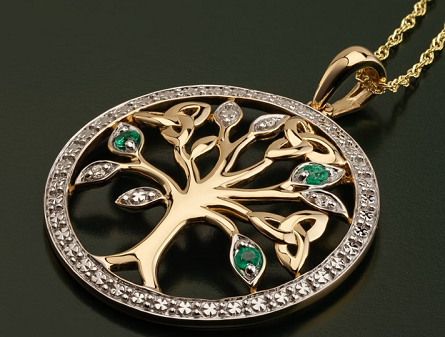The Celtic Tree of Life: A Connection Between Earth and Spirit
If one was asked to point to three things that can be said to be the top symbols of Celtic culture, it will be impossible not to include Crann Bethadh, which is Gaelic for Tree of Life, or generally referred to as the Celtic Tree of Life. This singular symbol provides deep insight into the beliefs and traditions of the Celts.
To these folk, trees were viewed with much reverence and deference as they were considered to be embodiments of the spirits of their departed forebears. These trees were seen as physical bridges between the physical world and the spiritual world. The Celtic Tree of Life (Crann Bethadh), therefore, captures the essence of this belief, making it a symbol of that connection between worlds.
If you want to learn about other important symbols of the Celtic people, you can read this article.
In this article, we will be discussing the Celtic tree of life with a view to helping the reader have a better understanding of it and the general belief system of the Celtic people.
Understanding the Spirituality and Beliefs of the Celts
The Celtic people are traditionally known to have a deep reverence for all things nature. To a Celt, the world around us is imbued with outer world beings. This belief applied even more to trees, as they were seen as being possessed with unique powers and qualities.
Different tree-types were considered to have specific attributes and powers. Below are some examples:
* Duir (Oak) – Because of its strength, it symbolized strength, wisdom, endurance and sovereignty. It was also associated with Dagda, one of the power Celtic gods.
* Idho (Yew) – This was associated with rebirth, death and eternity. The tree’s long life span spoke of life and longevity, while its poisonous berries spoke of death.
* Beith (Birch) – Also known as the Lady of the woods, it represented new beginnings and cleansing
The above are just a few examples to show just how much these people revered trees. In fact, tree groves were often regarded as sacred places where sacrifices and other rites were performed. They believed that the groves were the points from which they could easily connect with their gods and ancestors.
With this background, we can see that the Crann Bethadh (Tree of Life), captured this entire belief in its symbolic presentation. The branches, which reached into the clouds, mirrored the roots which stretched deep into the earth. This showed the Celtic belief that the skies and the earth are not two different entities but one connected and continuous entity.
They were simply seen as two sides of a coin, showing the duality of life – good and evil, death and life, light and darkness, joy and sadness, physical and spiritual etc. Everyone with a Celtic heritage should be encouraged to learn more about this ancient Celtic belief.
The Tree of Life in Celtic Communities
Given the importance of trees, in general and the concept of the tree of life in particular, in Celtic communities, it was common to have a tree centrally located in a Celtic village or community. This was often an ash or oak tree and was planted in the midst of the village as a physical representation of Crann Bethadh (tree of life).
As you can imagine, this tree played a central role in the activities of the village. With its symbolic role as the village guardian, among other things, rites, village gatherings and other important functions were carried out under its shadows. Cutting down or harming the tree in anyway was considered a sacrilegious act which attracted grievous penalties.
Crann Bethadh and the Modern Day Celtic Society
Many cultures have lost much of their essence to modernity and the Celts are not left out. However, as many young people turn to their virtual reality, losing touch with their culture and backgrounds, there are still a few who seek to learn about and understand their roots.
While a lot of the druid practices will have no place among modern day Celts, the concept and idea behind the tree of life and the duality of life remains relevant. To keep these beliefs and culture alive, some of these iconic symbols are now being made into artwork and jewelleries. You will even find the symbol tattooed on some bodies.
For the modern day Celt who wants to stay connected to their roots, you can get one of these artwork or jewelleries. You can visit https://celticbling.com/ to see some options that you can choose from. Proudly display this symbol, especially now that you have a better understanding of what it stands for.
Conclusion
Someone once said, “to move forward, you must first know where you are coming from.” Many cultures have become lost because some people thought they were no longer important. The Celtic people were a force to be reckoned with around Europe between 1200 BCE to 400 CE. The culture and heritage that was accumulated over this period should not just be allowed to wash away.
We’ve briefly explained an important concept in the history of this proud and strong people. Now, we as Celts have the opportunity to reawaken our understanding of our culture and tradition as embodied in the Crann Bethadh (tree of life). For a start, get this symbol in any form you can so that when anyone asks you about it, you get an opportunity to talk about your rich cultural heritage.

